wheel PONTIAC BONNEVILLE 1994 Owners Manual
[x] Cancel search | Manufacturer: PONTIAC, Model Year: 1994, Model line: BONNEVILLE, Model: PONTIAC BONNEVILLE 1994Pages: 290, PDF Size: 14.75 MB
Page 14 of 290
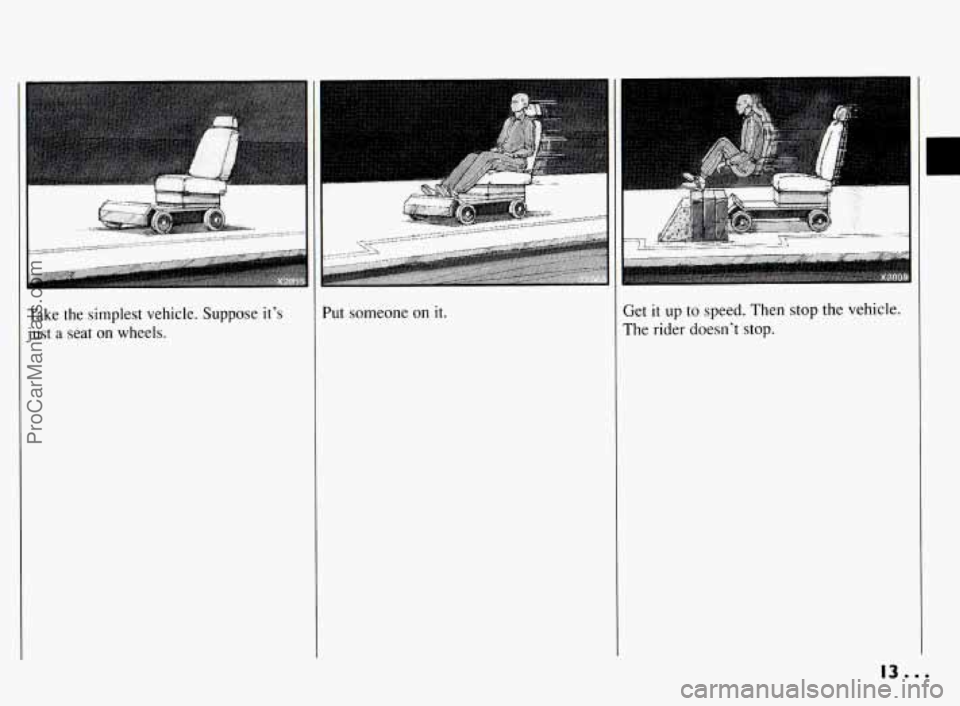
Take
just a the simplest vehicle.
seat on wheels. Suppose it’s
..- , . . I
Get it up
to speed. Then stop the vehicle.
The rider doesn’t stop.
l3., .
ProCarManuals.com
Page 23 of 290
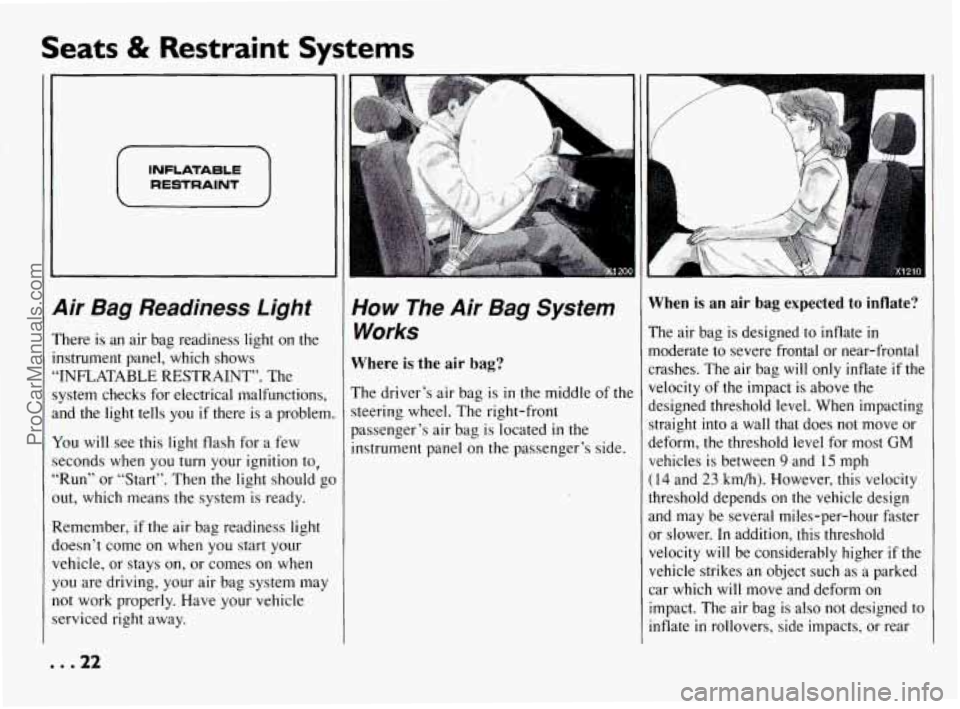
Seats & Restraint Systems
INFLATABLE
RESTRAINT
9ir Bag Readiness Light
’here is an air bag readiness light on the
xtrument panel, which shows
INFLATABLE RESTRAINT”. The
ystem checks for electrical malfunctions,
nd the light tells you
if there is a problem.
’ou will see this light flash for a few
xonds when
you turn your ignition to,
Run” or “Start”. Then the light should gc
ut, which means the system is ready.
.emember, if the air bag readiness light
oesn’t come on when you start your
ehicle, or stays on, or comes
on when
ou are driving, your air bag system may
ot work properly. Have your vehicle xviced right away.
. .22
I
HOW The Air Bag System When is an air bag expected to inflate?
moderate to severe frontal or near-frontal
Works The air bag is designed to inflate in
Where is the air bag? crashes. The air bag will only inflate if the
The driver’s air bag is
in the middle of the
steering wheel. The right-front
passenger’s air bag is located
in the
instrument panel
on the passenger’s side. velocity
of the impact is above the
designed threshold level. When impacting straight into a wall that does not move or
deform, the threshold level for most GM
vehicles is between 9 and 15 mph
(14 and 23 km/h). However, this velocity
threshold depends on the vehicle design
and may be several miles-per-hour faster or slower. In addition, this threshold
velocity will be considerably higher
if the
vehicle strikes an object such as a parked
car which will move and deform on impact. The air bag is also not designed to
inflate
in rollovers, side impacts, or rear
ProCarManuals.com
Page 24 of 290
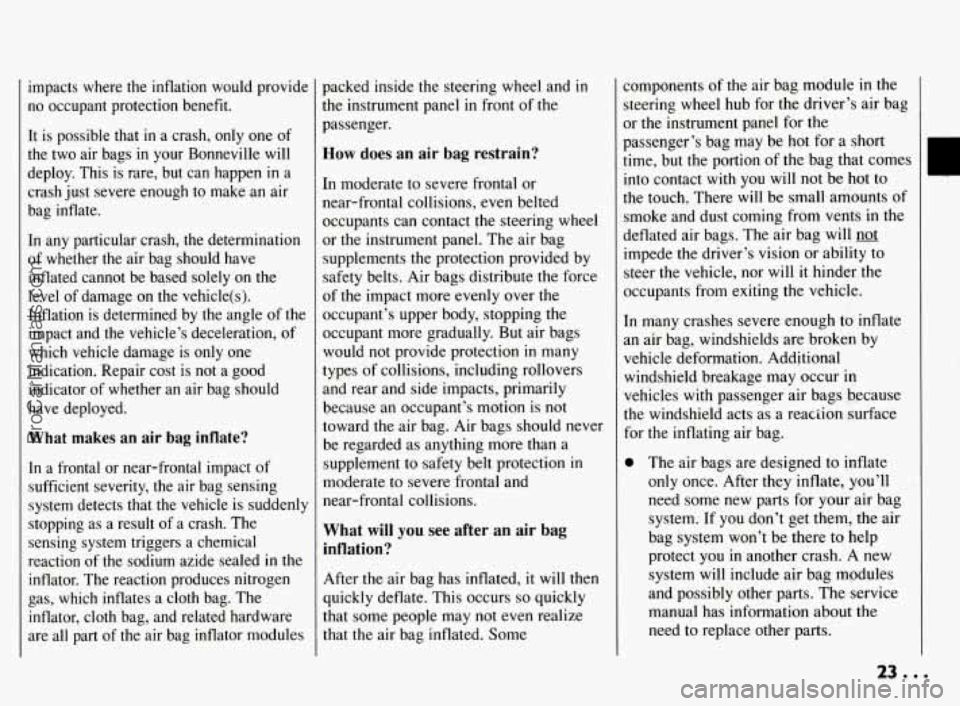
impacts where the inflation would provide
no occupant protection benefit.
It is possible that
in a crash, only one of
the two air bags in your Bonneville will
deploy. This is rare, but can happen
in a
crash just severe enough to make an air
bag inflate.
In any particular crash, the determination
of whether the air bag should have
inflated cannot be based solely on the
level
of damage on the vehicle(s).
Inflation is determined by the angle of the
impact and the vehicle’s deceleration, of
which vehicle damage is only one
indication. Repair cost is not a good
indicator of whether an air bag should
have deployed.
What makes an air bag inflate?
In a frontal or near-frontal impact of
sufficient severity, the air bag sensing
system detects that the vehicle
is suddenly
stopping as a result of a crash. The
sensing system triggers a chemical
reaction of the sodium azide sealed in the
inflator. The reaction produces nitrogen
gas, which inflates a cloth bag. The
inflator, cloth bag, and related hardware
are all part of the air bag inflator modules packed
inside the steering wheel and
in
the instrument panel in front of the
passenger.
How does an air bag restrain?
In moderate to severe frontal or
near-frontal collisions, even belted
occupants can contact the steering wheel or the instrument panel. The air bag
supplements the protection provided by
safety belts. Air bags distribute the force
of the impact more evenly over the
occupant’s upper body, stopping the
occupant more gradually. But air bags
would not provide protection in many
types of collisions, including rollovers
and rear and side impacts, primarily
because an occupant’s motion is not
toward the air bag. Air bags should never
be regarded as anything more than a
supplement to safety belt protection
in
moderate to severe frontal and
near-frontal collisions.
What will you see after an air bag
inflation?
After the air bag has inflated, it will then
quickly deflate. This occurs
so quickly
that some people may not even realize
that the air bag inflated. Some components of the
air bag module in the
steering wheel hub for the driver’s air bag
or the instrument panel for the
passenger’s bag may be hot for a short
time, but the portion of the bag that comes
into contact with you will not be hot to
the touch. There will be small amounts of
smoke and dust coming from vents in the
deflated air bags. The air bag will
not
impede the driver’s vision or ability to
steer the vehicle, nor will it hinder the
occupants from exiting the vehicle.
In many crashes severe enough to inflate
an air bag, windshields are broken by
vehicle deformation. Additional
windshield breakage may occur in
vehicles with passenger air bags because
the windshield acts as a reac’lion surface
for the inflating air bag.
The air bags are designed to inflate
only once. After they inflate, you’ll
need some new parts for your air bag
system. If you don’t get them, the air
bag system won’t be there to help
protect you in anpther crash.
A new
system will include air bag modules
and possibly other parts. The service
manual has information about the
need to replace other parts.
C
23...
ProCarManuals.com
Page 25 of 290
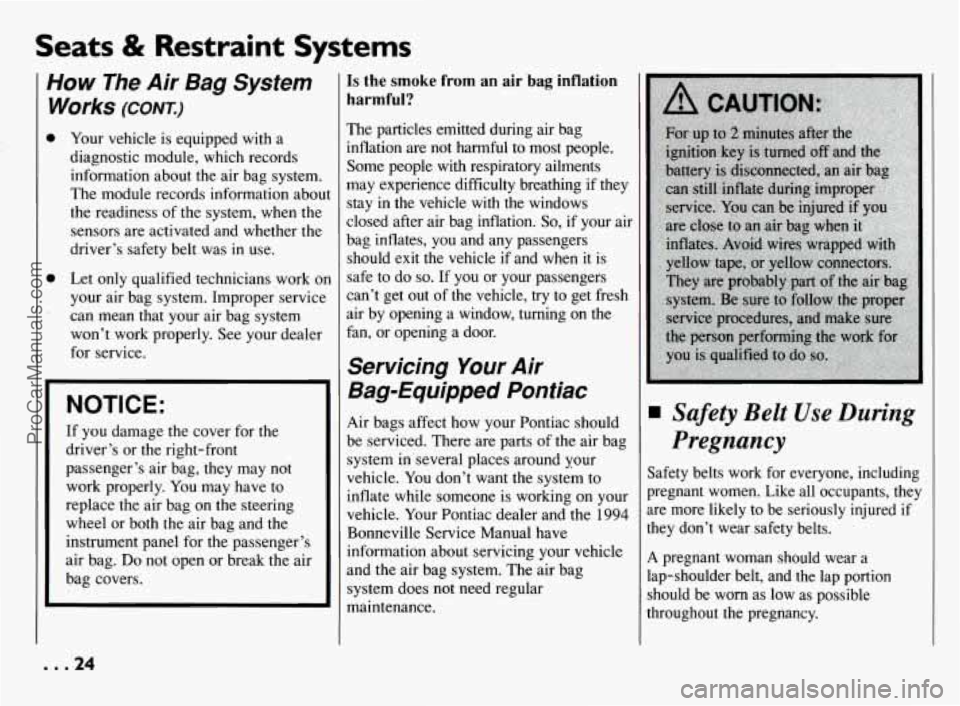
Seats & Restraint Systems
How The Air Bag System
Works (CONK)
e
e
Your vehicle is equipped with a
diagnostic module, which records
information about the air bag system.
The module records information about
the readiness of the system, when the
sensors are activated and whether the
driver’s safety belt was in use.
Let only qualified technicians work on
your air bag system. Improper service
can mean that your air bag system
won’t work properly. See your dealer
for service.
NOTICE:
If you damage the cover for the
driver’s or
the right-front
passenger’s air bag, they may not
work properly. You may have to
replace the air bag on the steering
wheel or both the air bag and the
instrument panel for the passenger’s
air bag.
Do not open or break the air
bag covers.
Is the smoke from an air bag inflation
harmful?
The particles emitted during air bag
inflation are not harmful to most people.
Some people with respiratory ailments
may experience difficulty breathing if they
stay
in the vehicle with the windows
closed after air bag inflation.
So, if your air
bag inflates,
you and any passengers
should exit the vehicle
if and when it is
safe to
do so. If you or your passengers
can’t get out of
the vehicle, try to get fresh
air by opening a window, turning on the
fan, or opening a door.
Servicing Your Air
Bag-Equipped Pontiac
Air bags affect how your Pontiac should
be serviced. There are parts of the air bag
system in several places around xour
vehicle. You don’t want the system to
inflate while someone is working on your
vehicle. Your Pontiac dealer and the
1994
Bonneville Service Manual have
information about servicing your vehicle
and the air bag system. The air bag
system does not need regular
maintenance.
Safety Belt Use During
Pregnancy
Safety belts work for everyone, including
pregnant women. Like all occupants, they
are more likely to be seriously injured if
they don’t wear safety belts.
A pregnant woman should wear a
lap-shoulder belt, and the lap portion should be worn as low as possible
throughout the pregnancy.
... 24
ProCarManuals.com
Page 48 of 290
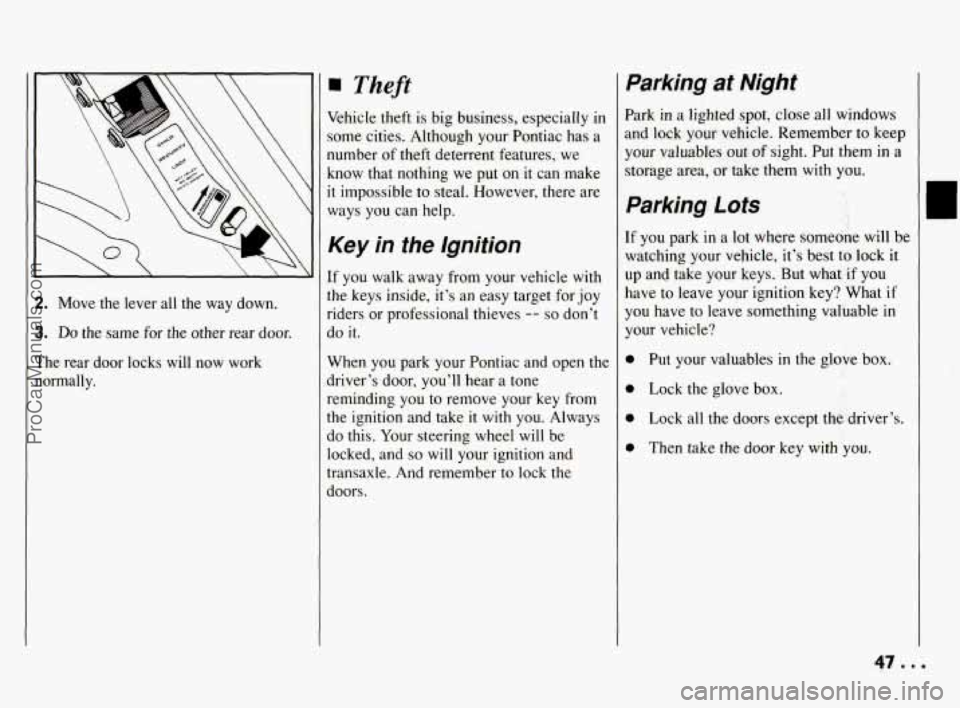
2. Move the lever all the way down.
3. Do the same for the other rear door.
The rear door locks will now work
normally.
Theft
Vehicle theft is big business, especially in
some cities. Although your Pontiac has a
number
of theft deterrent features, we
know that nothing we put on
it can make
it impossible to steal. However, there are
ways you can help.
Key in the lgnition
If you walk away from your vehicle with
the keys inside,
it’s an easy target for joy
riders or professional thieves
-- so don’t
do it.
When you park your Pontiac and open the
driver’s door, you’ll hear a tone
reminding you
to remove your key from
the ignition and take it with you. Always
do this. Your steering wheel will be
locked, and
so will your ignition and
transaxle. And remember to lock the
doors.
Parking at Night
Park in a lighted spot, close all windows
and lock your vehicle. Remember
to keep
your valuables out
of sight. Put them in a
storage area, or take them with you.
Parking Lots
If you park in a lot where someone will be
watching your vehicle, it’s best to lock
it
up and take your keys. But what if you
have
to leave your ignition key? What if
you have to leave something valuable in
your vehicle?
0 Put your valuables in the glove box.
0 Lock the glove box.
0 Lock all the doors except the driver’s.
0 Then take the door key with you.
47.0.
ProCarManuals.com
Page 54 of 290
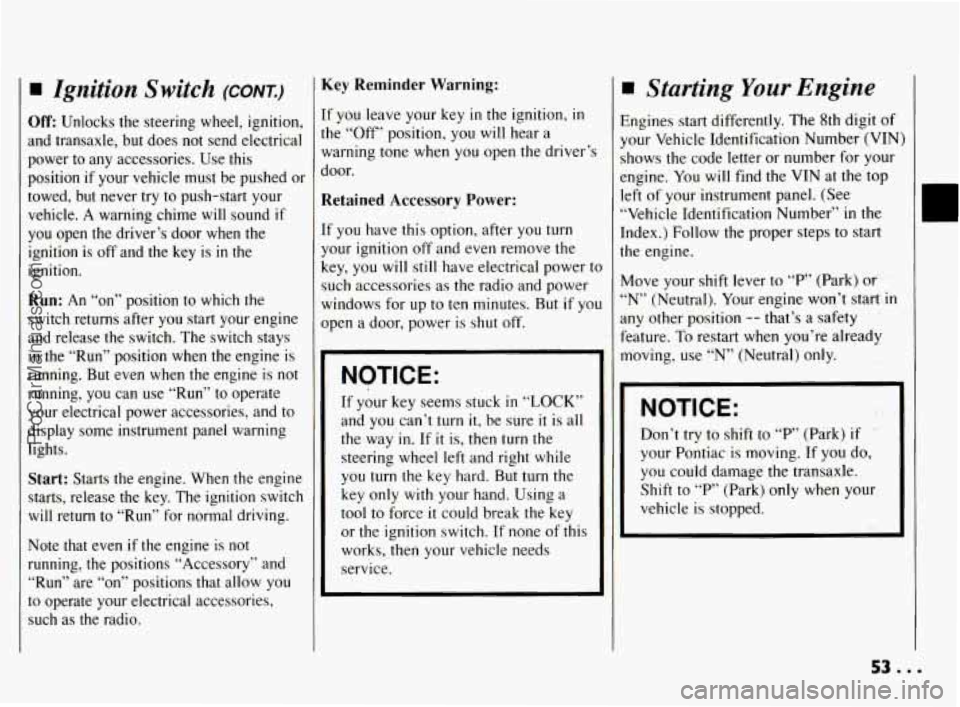
Ignition Switch (CONK)
Off: Unlocks the steering wheel, ignition,
and transaxle, but does not send electrical
power to any accessories. Use this
position
if your vehicle must be pushed or
towed,
but never try to push-start your
vehicle.
A warning chime will sound if
you open the driver’s door when the
ignition is off and the key is
in the
ignition.
Run: An “on” position to which the
switch returns after you start your engine
and release the switch. The switch stays
in the “Run” position when the engine is
running. But even when the engine is not
running, you can use “Run” to operate
your electrical power accessories, and to
display some instrument panel warning
lights.
Start: Starts the engine. When the engine
starts, release the key. The ignition switch
will return to “Run” for normal driving.
Note
that even if the engine is not
running, the positions “Accessory” and
“Run” are “on” positions that allow you
to operate your electrical accessories,
such as the radio.
Key Reminder Warning:
If you leave your key in the ignition, in
the “Off’ position, you will hear a
warning tone when you open the driver’s
door.
Retained Accessory Power:
If you have this option, after you turn
your ignition
off and even remove the
key, you
will still have electrical power to
such accessories as the radio and power
windows for
up to ten minutes. But if you
open
a door, power is shut off.
NOTICE:
If your key seems stuck in “LOCK”
and you can’t turn it, be sure it is all
the way
in. If it is, then turn the
steering wheel left and right
while
you turn the key hard. But turn the
key only
with your hand. Using a
tool to force it could break the key
or the ignition switch. If none
of this
works,
then your vehicle needs
service.
Starting Your Engine
Engines start differently. The 8th digit of
your Vehicle Identification Number (VIN)
shows the code letter or number for your
engine. You
will find the VIN at the top
left of your instrument panel. (See
“Vehicle Identification Number”
in the
Index.) Follow the proper steps to start
the engine.
Move your shift lever to
“P’ (Park) or
“N” (Neutral). Your engine won’t start in
any other position -- that’s a safety
feature. To restart when you’re already
loving, use
“N” (Neutral) only.
NOTICE:
Don’t try to shift to “P” (Park) if
your Pontiac is moving. If you do,
you could damage the transaxle.
Shift to
“P” (Park) only when your
vehicle is stopped.
ProCarManuals.com
Page 57 of 290
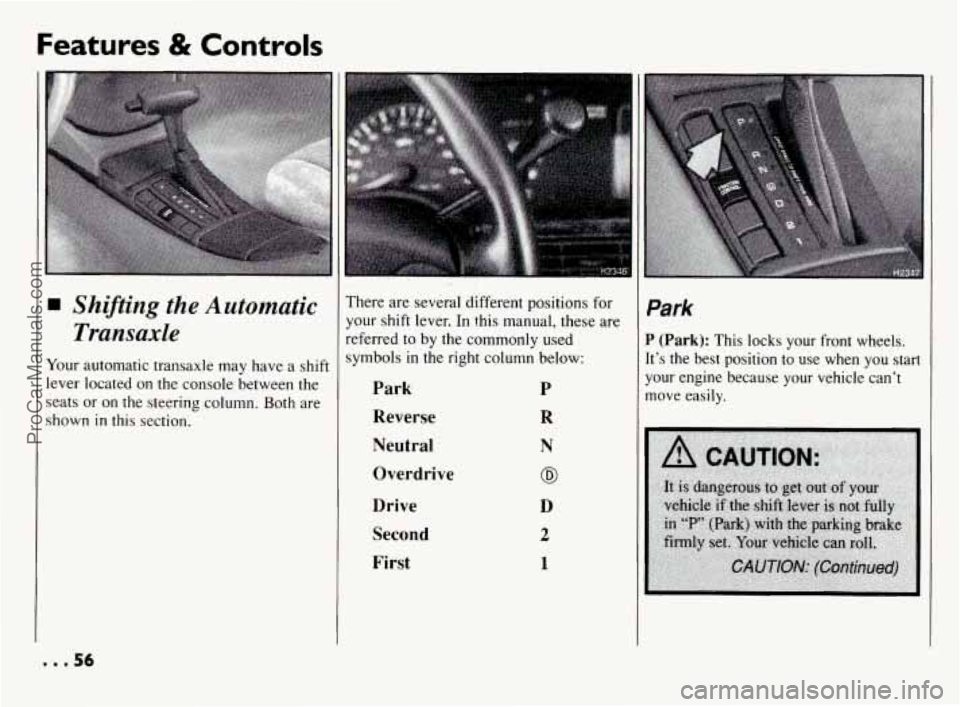
Features & Controls
Shifting the Automatic Transaxle
Your automatic transaxle may have a shift
lever located on the console between the
seats or
on the steering column. Both are
shown
in this section.
1
There are several different positions for
your shift lever. In this manual, these are
referred to by the commonly used
symbols in the right column below:
Park
Reverse
Neutral
Overdrive
Drive Second
First P
R
N
@
D
2
1
Park
P (Park): This locks your front wheels.
It’s the best position
to use when you start
your engine because your vehicle can’t
move easily.
... 56
ProCarManuals.com
Page 59 of 290
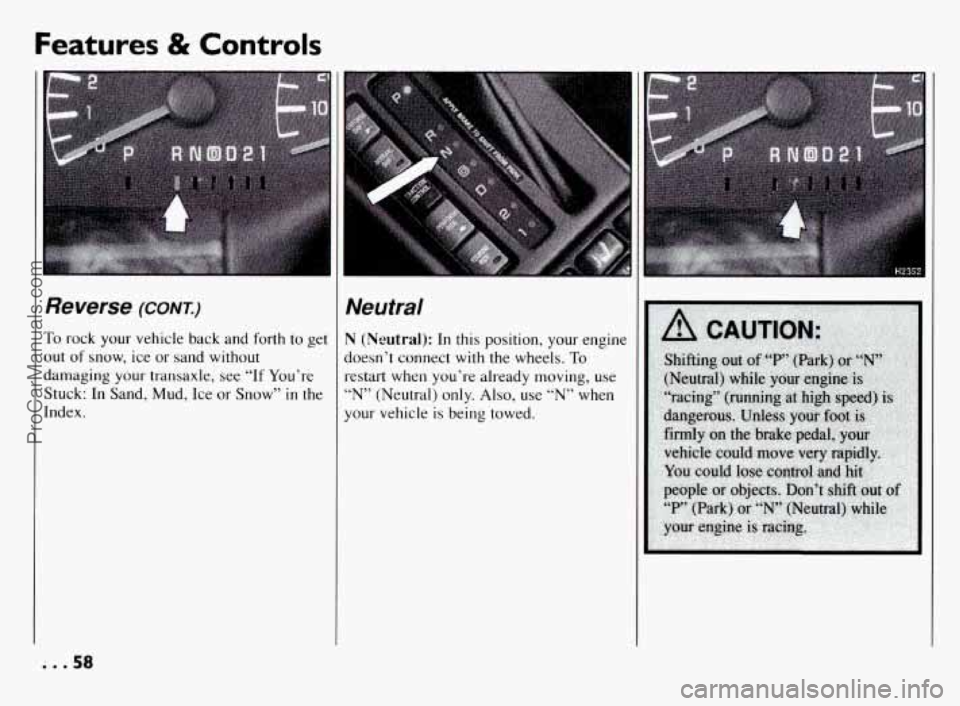
Features & Controls
I
Reverse (CONT.)
To rock your vehicle back and forth to get
out of
snow, ice or sand without
damaging your transaxle, see
“If You’re
Stuck: In Sand, Mud, Ice
or Snow” in the
Index.
Neutral
N (Neutral): In this position, your engine
doesn’t connect with the wheels.
To
restart when you’re already moving, use
“N” (Neutral) only. Also, use “N’ when
your vehicle is being towed.
... 58
ProCarManuals.com
Page 61 of 290
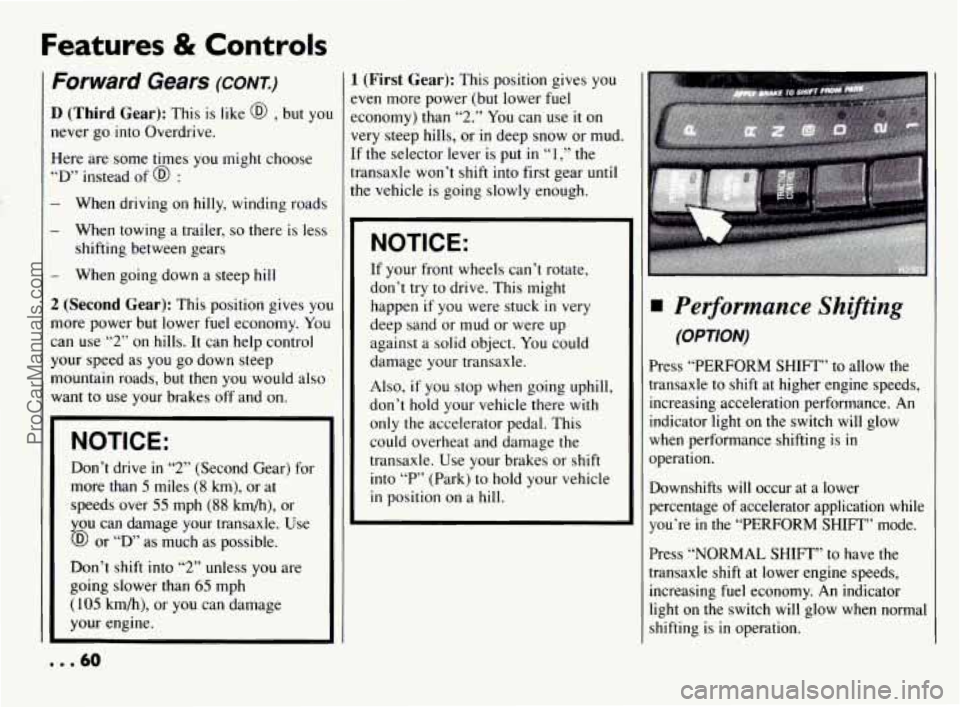
Features & Controls
Forward Gears (CONT)
D (Third Gear): This is like @ , but you
never
go into Overdrive.
Here are some times you might choose
“D’ instead of @ :
- When driving on hilly, winding roads
- When towing a trailer, so there is less
shifting between gears
- When going down a steep hill
2 (Second Gear): This position gives you
more power but lower
fuel economy. You
can use “2” on hills.
It can help control
your speed as you
go down steep
mountain roads, but
then you would also
want
to use your brakes off and on.
NOTICE:
Don’t drive in “2” (Second Gear) for
more than
5 miles (8 km), or at
speeds over
55 mph (88 km/h), or
you can damage your transaxle. Use
@ or “D’ as much as possible.
Don’t shift into “2” unless
you are
going slower than
65 mph
( 105 km/h), or you can damage
your engine.
1 (First Gear): This position gives you
even more power (but lower fuel economy) than
“2.” You can use it on
very steep hills, or in deep snow or mud.
If the selector lever is put
in “1,” the
transaxle won’t shift into first gear until
the vehicle is going slowly enough.
NOTICE:
If your front wheels can’t rotate,
don’t try to drive. This might
happen
if you were stuck in very
deep sand or mud or were up
against a solid object. You could
damage your transaxle.
Also,
if you stop when going uphill,
don’t hold your vehicle there with
only the accelerator pedal. This could overheat and damage the
transaxle. Use your brakes or shift
into
“P’ (Park) to hold your vehicle
in position on a hill.
Performance Shiftins
(OPTION)
Press “PERFORM SHIFT” to allow the
transaxle to shift at higher engine speeds,
increasing acceleration performance.
An
indicator light on the switch will glow
when performance shifting is in
operation.
Downshifts
will occur at a lower
percentage of accelerator application while
you’re
in the “PERFORM SHIFT” mode.
Press “NORMAL
SHIFT” to have the
transaxle shift at lower engine speeds,
increasing fuel economy.
An indicator
light on the switch will glow when normal
shifting
is in operation.
... 60
ProCarManuals.com
Page 68 of 290
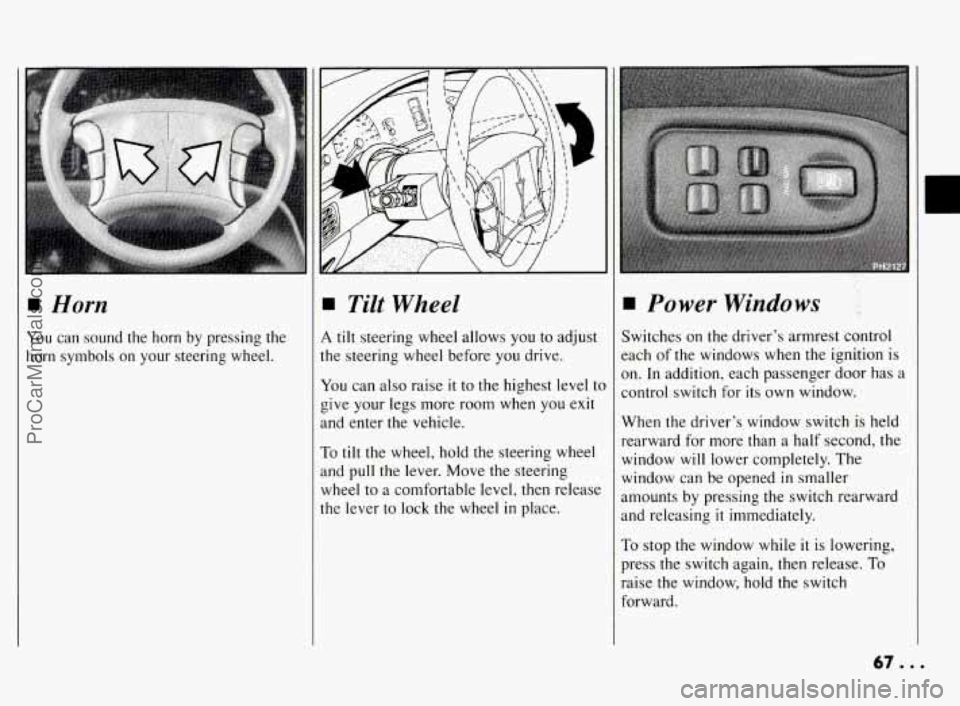
1 Horn
You can sound the horn by pressing the
horn symbols on your steering wheel.
Tilt Wheel
4 tilt steering wheel allows you to adjust
he steering wheel before
you drive.
Ir'ou can also raise it to the highest level tc
give your legs more room when you exit
tnd enter the vehicle.
To tilt the wheel, hold the steering wheel
tnd
pull the lever. Move the steering
Nheel to a comfortable level, then release
he lever to lock the wheel
in place.
Power Windows ,I
Switches on the driver's armrest control
each of the windows when the ignition is
on. In addition, each passenger door has
a
control switch for its own window:
When the driver's window switch
is held
rearward for more
than a half second, the
window
will lower completely. The
window can be opened
in smaller
amounts by pressing the switch rearward
and releasing
it immediately.
To stop the window while
it is lowering,
press the switch again, then release.
To
raise the window, hold the switch
forward.
67 ...
ProCarManuals.com